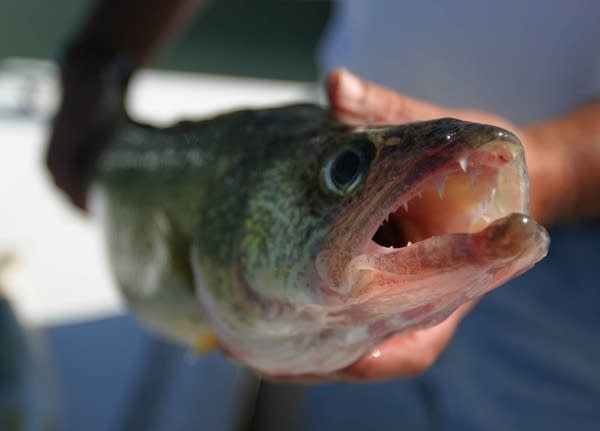At Mille Lacs, worries over low walleye numbers
Go Deeper.
Create an account or log in to save stories.
Like this?
Thanks for liking this story! We have added it to a list of your favorite stories.

This fall, the Minnesota Department of Natural Resources' annual gillnet survey in Lake Mille Lacs turned up half as many walleye as last year — a 40-year low.
At a closed-door meeting in Duluth this week, scientists and researchers with the agency discussed the survey results and other data with tribes that also fish the lake. But at least at this point, it's hard to know what the DNR's numbers mean.
DNR officials say they're "very concerned" about the walleye population in Mille Lacs, the walleye-fishing jewel of Minnesota that's also central to the region's economy.
Last year, net surveys at 52 locations around Mille Lacs showed on average 9.7 walleye per net. But this fall the agency found only 4.8 walleye per net — the lowest catch rate since 1972.
Turn Up Your Support
MPR News helps you turn down the noise and build shared understanding. Turn up your support for this public resource and keep trusted journalism accessible to all.
In a letter to resort and business owners on the lake, Rick Bruesewitz, the Aitkin area fisheries supervisor, explained the walleye — especially the larger ones — were in "poorer condition" compared to previous years.
Bruesewitz said more analysis needs to be done to determine if the test results actually reflect what's happening in the lake.
"A halving is a bigger drop than we typically see," he said. "On the other hand, a drop of four fish per net, or five fish per net, isn't necessarily an extreme drop."
"We are putting all the information together to develop a picture of what's going on."
This year's test results continue a decline in walleye that dates back to 2009, according to agency data.
Bruesewitz said it's too early to predict whether even more restrictions are needed on the number or size of fish anglers can keep.
"We have low catches," he said. "Therefore we're concerned. The second part is, at this point in time we're unsure what it means, but we are putting all the information together to develop a picture of what's going on."
Bruesewitz said it's not easy to figure out what's impacting one species of fish in a complex ecosystem. He said the causes could be related to invasive plants, or invasive species like zebra mussels. Mussels, for instance, can reduce food for larval fish. Bruesewitz said the dip in walleye could also be related to behavioral changes in the fish population.
LAKE MANAGEMENT SCRUTINIZED
This week's meeting in Duluth examined in part how the lake is managed.
"We're trying to do the best job we can to separate the natural fluctuations from the human-induced fluctuations," said Don Pereira, a senior research biologist with the DNR.
Tribes that fish the lake also do tests to count the number of fish that have hatched this year, but they haven't released their findings publicly.
Charlie Rasmussen, a spokesman for the Great Lakes Indian Fish and Wildlife Commission, said the commission is closely monitoring the DNR's findings.
"Both the tribes and the DNR will take that data back and then they'll be able to analyze it ... and talk about the results from the surveys and what the models are telling the managers about the fishery," Rasmussen said.

By most accounts, fishing on Lake Mille Lacs this year was good. But for some that rely on the lake's draw, there's concern that the net survey results could mean more fishing restrictions that could ultimately hurt business.
Bill Lundeen, owner of Lundeen's Tackle Castle in Onamia, said his business did well this season, but adds that the DNR's data is troubling.
"People will go, 'Oh, there only half the fish in Mille Lacs and maybe I went up the third week of July this year and struggled a little bit so I'm not going back there if it's half as good as when it was hard.' Some people will think that way," Lundeen said.
Lundeen and other stake holders will have an opportunity to weigh in when they meet with the DNR possibly sometime before the end of the year.
Dear reader,
Political debates with family or friends can get heated. But what if there was a way to handle them better?
You can learn how to have civil political conversations with our new e-book!
Download our free e-book, Talking Sense: Have Hard Political Conversations, Better, and learn how to talk without the tension.




